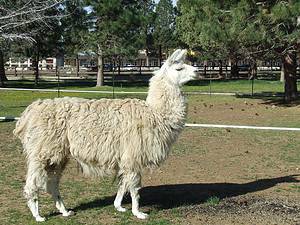Llamas are cute, but what makes them even better human companions is their gentleness and empathy. People from their native habitat, the Andes Mountains in South America, dub them as “silent brothers”. This is because they can recognize and empathize with human emotions. Llamas are also one of the most harmless animals on the entire planet, as well as one of the friendliest.
Llamas are typically found in mountainous deserts and grasslands, and are fast becoming designer pets. Many non-traditional pet lovers and others who can afford them take them in as pets. Llamas are closely related to camels and are included in the family Camelidae which includes alpacas, vicuñas, and guanacos. The two latter animals are often found in the wild, while camels, alpacas, and llamas are domesticated.
Llamas have a highly-specialized digestive system that differs from those of ruminants such as sheep, cattle, horses, and goats. However, like ruminants, they also lack upper front teeth.
What Kind of Teeth Do Llamas Have?
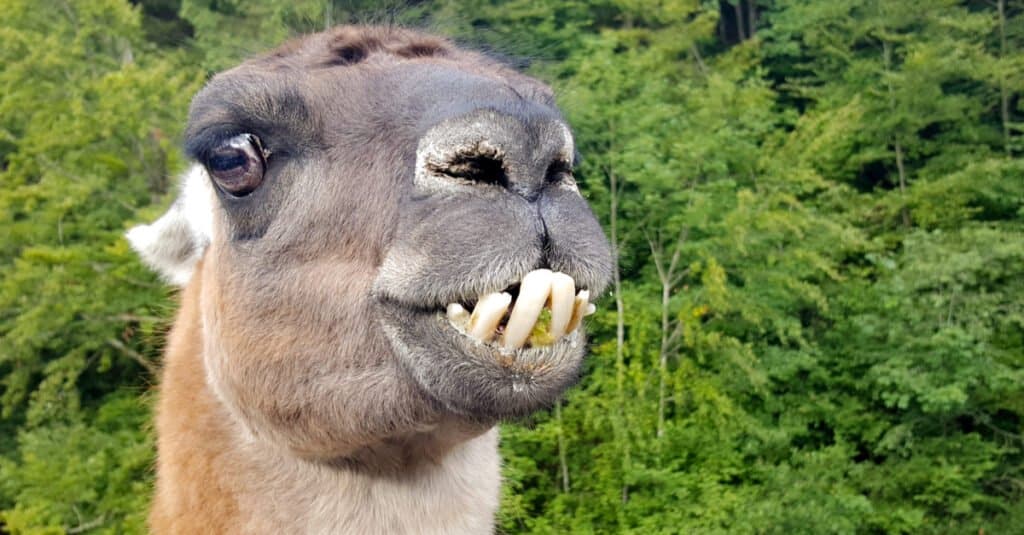
Llamas have sharp, pointed canines that are called “fighting teeth”.
©Johan C. op den Dries/Shutterstock.com
Llamas have three pairs of incisors or front teeth located only at their bottom jaw. Followed by these incisors are one to two pairs of premolars, and three pairs of molars, collectively called “cheek teeth”. They are located both at the top and bottom mandible. However, what makes a llama’s dental structure unique is a set of fighting teeth that looks like fangs, composed of modified canines and incisors. Intact male llamas possess two pairs of fighting teeth on their upper jaw and one pair at the lower jaw.
Like most mammals, they have a complete set of teeth, composed of incisors, canines, premolars, and molars. Not all llamas have canines, though. Intact male llamas have sharp, pointed canines that are called fighting teeth, located after the front teeth. For the upper mandible, the fighting teeth are the first set of real teeth that are visible from the entrance of the mouth. Female llamas usually have undeveloped fighting teeth, and castrated males often have them smaller.
Fighting teeth usually erupt around 2 to 3 years of age for males, while females usually have them in their fourth or fifth year.
How Many Teeth Do Llamas Have?
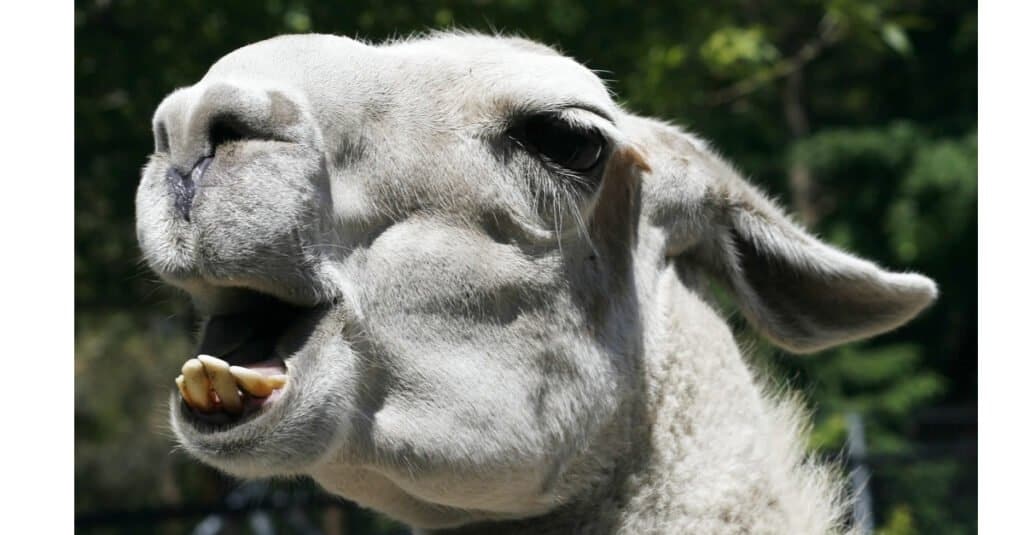
Llamas have 30-32 teeth.
©Joy Brown/Shutterstock.com
An adult llama should have a complete set of 30 to 32 permanent teeth unless interrupted by dental problems. As diphyodonts like humans and dogs, llamas have two sets of teeth throughout their lifespan: the deciduous set, commonly called milk teeth or baby teeth, and the permanent set which replaces the milk teeth and stays for the rest of their lives unless affected by dental issues.
Llamas’ deciduous teeth fall out voluntarily as permanent ones erupt. An adult llama’s typical dental formula is as follows: Incisors 1/3, Canines 1/1, Premolars 2/1, Molars 3/3.
Do Llamas Have Top Teeth?
Like most ruminants and camelids, llamas do not have front teeth in their upper jaws. This is why when you take a closer look at a chewing llama, you will notice that only its lower jaw has visible teeth. In place of the upper front teeth is a toothless, rubbery plate or dental pad that aids them in chewing. This dental pad is located directly above the six incisors to strategically help llamas snatch and cut grass from the ground like scissors do, and tear them with their incisors.
There, however, is one pair of incisors on top of the lower jaw that acts as canines and is categorized as fighting teeth rather than front teeth.
Llamas and alpacas have quite similar dental structures, including the number and distribution of teeth. One common nuisance for both mammals is the tendency of their lower incisors to stick out. Llama teeth, especially the front teeth, need to be trimmed regularly, because if they are left neglected, they can grow really long and may “stick out”, extending beyond their dental pad and protruding outside their top lip. When this happens, llamas will experience difficulty in eating. This can even cause their teeth to break off.
What Do Llamas Use Their Teeth For?
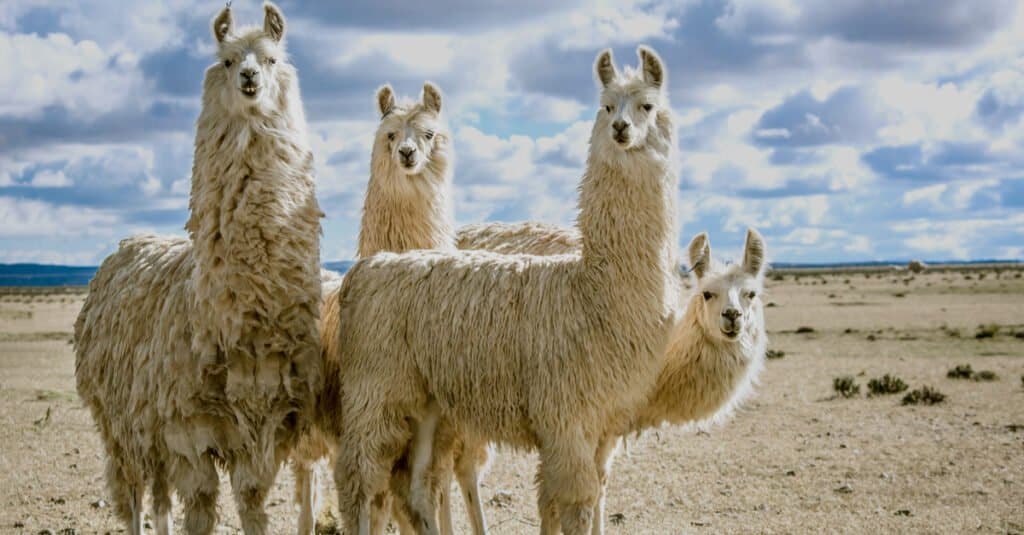
Llamas use their teeth to eat plant materials like grass and hay.
©Noe Besso/Shutterstock.com
Llamas are herbivores, which means they eat exclusively plant materials, such as grass, hay, shrubs, and flowering plants. They do not feed on meat and other tough materials like nuts or shells as their teeth are mainly designed for crushing, grinding, and juicing their food.
Llamas use their teeth the same way goats, cows, camels, and sheep do. They cut grass from the ground using their sharp-edged incisors and dental pad, tear them, and push them towards the cheek teeth or the grinding teeth to further be chewed. Like ruminants, llamas are often spotted chewing because they regurgitate their food and chew them repeatedly before digesting.
Llamas are dubbed as “pseudo ruminants” as they have almost the same digestive tract as that of ruminants. Ruminants are distinctly known to chew their food, digest them, regurgitate them, chew them again, and swallow them back for complete digestion. Llamas’ cheek teeth are very useful as they repeatedly chew on their food and cud.
What Are Llamas’ Fighting Teeth For?
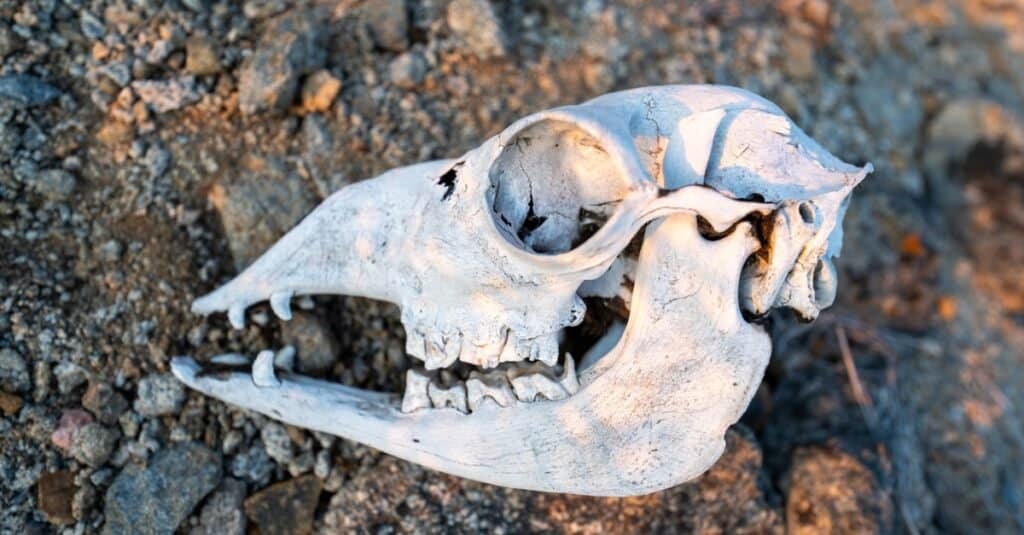
The skull of a guanaco (closely related to a llama) shows the fighting teeth at the front of its mouth.
©iStock.com/Oscar Gutierrez Zozulia
It is completely harmless to put your fingers close to a llama’s mouth when feeding them but it isn’t advisable to poke your fingers deeper into their mouth. This is because llamas have needle-sharp canines right at the back of their incisors that can be dangerous for people and other animals. Male llamas use these canines to fight other male llamas, thus the name “fighting teeth”. When they are fighting, male llamas are known to use these fighting teeth in cutting and wounding the ears and legs of their competitors, as well as other male llamas’ genitals. As herbivorous mammals, llamas do not need these canines for eating. Therefore, their fighting teeth can be removed for safety purposes.
The photo featured at the top of this post is © Noe Besso/Shutterstock.com
Thank you for reading! Have some feedback for us? Contact the AZ Animals editorial team.





